Wild Rift Beginner's Guide
1. What is Wild Rift?
League of Legends: Wild Rift is a multiplayer online battle arena (MOBA) for mobile.
It’s the mobile version of League of Legends that launched in the Americas as of March 29th on Android and IOS.
Like in League of Legends, in Wild Rift, five players compete against other five players, with everyone choosing a single champion to use in Summoner’s Rift.
What is a champion?
Each player on every side of the team has to pick up a champion and every player can control only the one they chose to play with. There are currently over 50 Champions in the game and there will be added a lot of new ones over time. Every champion has its own abilities and powers with a variety of playstyles.
Before you hop in a game of Wild Rift you will get in the champion select and each team has to decide which one they are going to play. There are different strategies and champions that work very well together.
2. How do you win?
There are two different ways to win a game of League of Legends: Wild Rift, the first one is to destroy their base (Nexus) and the second one is if your opponent surrenders the game.

But it isn’t that easy to destroy the base of the opponent because before you even get to the base, you will have to destroy all the enemy turrets in at least one lane before you get access to the enemy Nexus.
3. What is Summoner’s Rift?
There is currently only one map available in League of Legends: Wild Rift and it has the same name as the main one in League of Legends but there will be released new ones in the future.
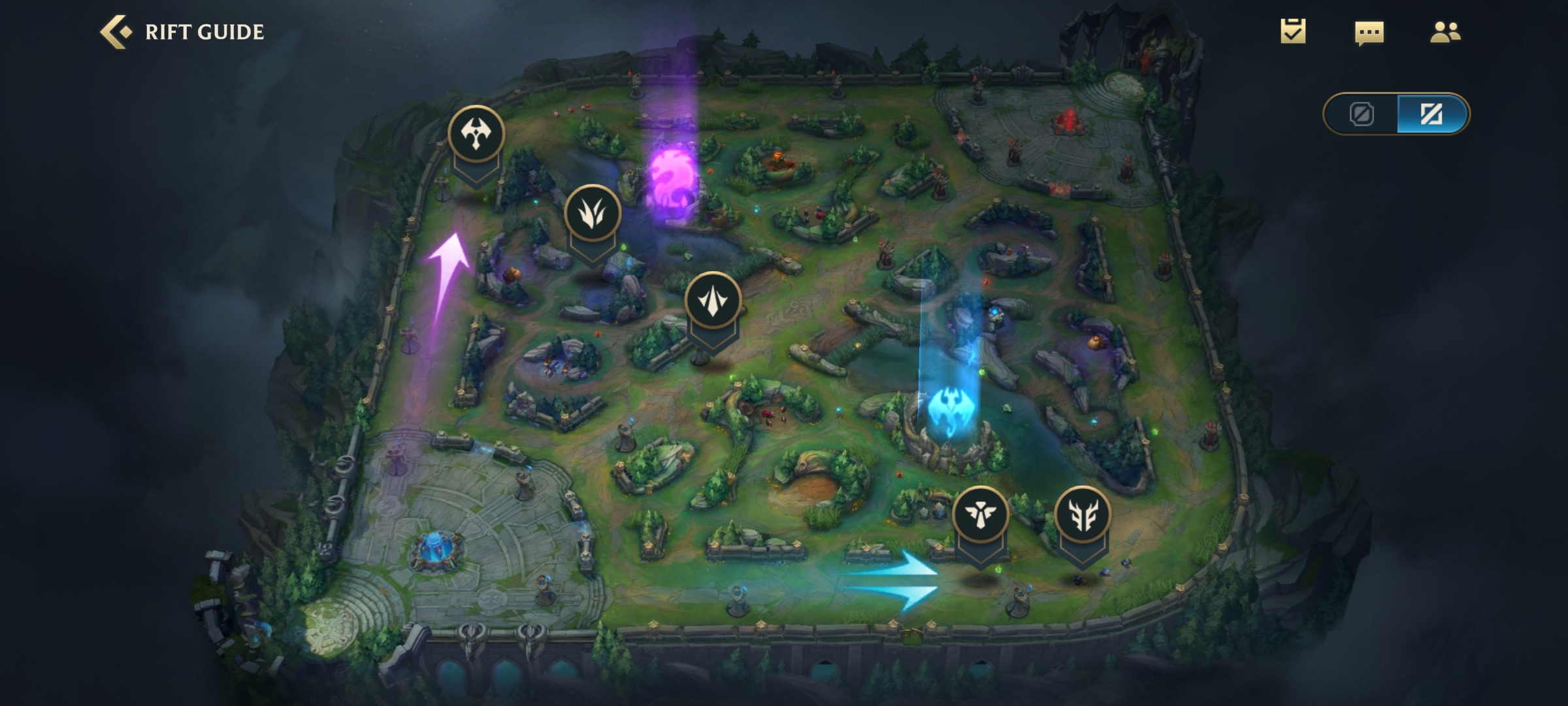
The Summoners Rift is split by a river into two sides the red side and the blue side. On each side, there will be one team of five players.
There are 3 lanes, the mid lane, the top lane, and the bot lane. There is also a jungle on each side of the map that contains jungle camps.
From the base of each side, there will be spawning minions that run into each lane.
Turrets
There are exactly 9 turrets in League of Legends: Wild Rift, 3 on each lane. The first ones are tier 1 turrets, the second ones are called tier 2 turrets and the last ones are called the inhibitor turrets.
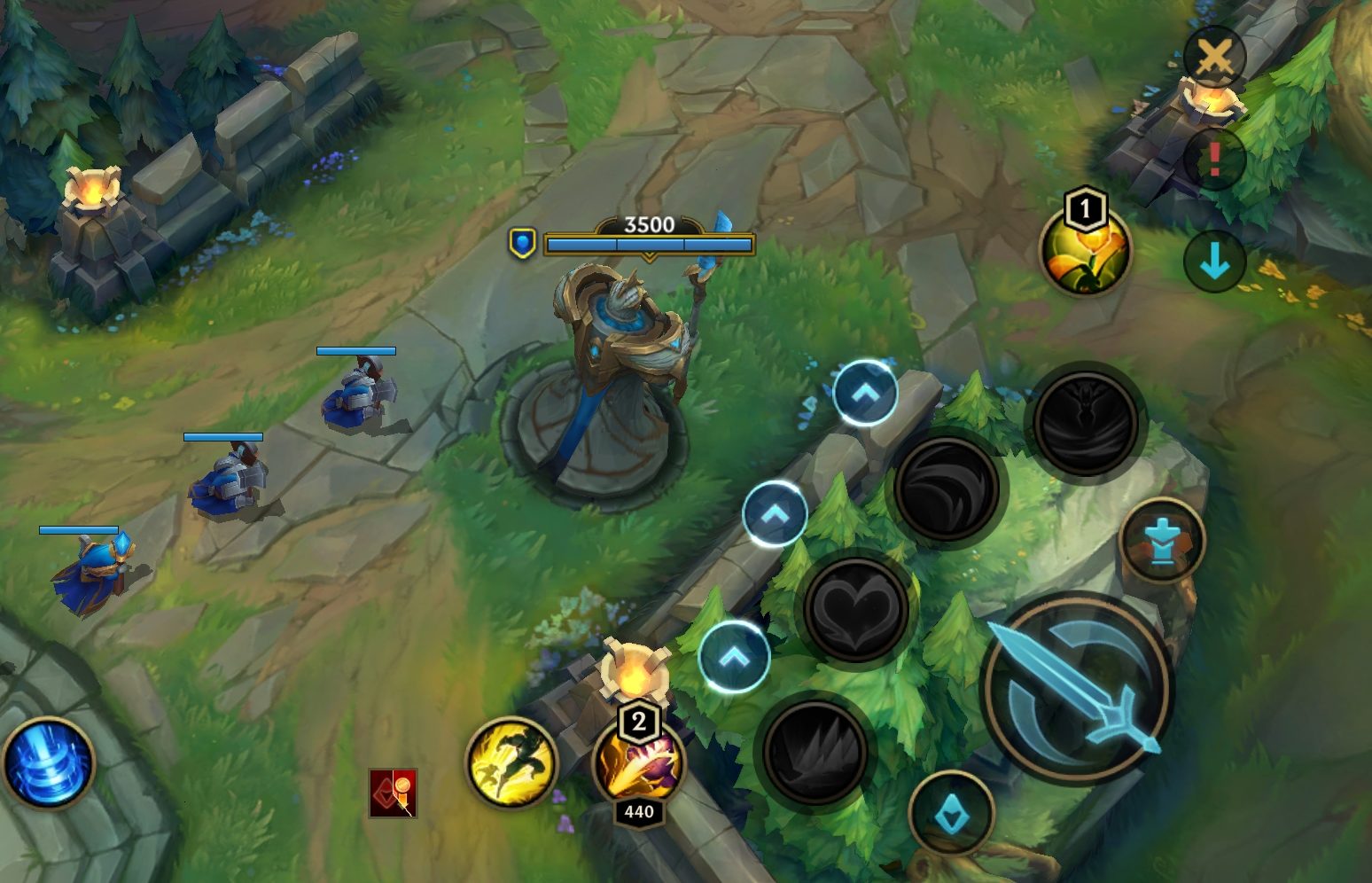
Every time your team destroys a turret it gains gold for the whole team and yourself. All turrets have three platings that give extra gold with each one destroyed.
Once the inhibitor turret is destroyed your team will have access to the opposing team’s base and get rewarded with super minions.
The Fountain and Shop
Right at the start of a game Wild Rift, each team will spawn in the fountain. You will be more often the fountain since every time you die, you will spawn in the fountain, where also the shop is located.
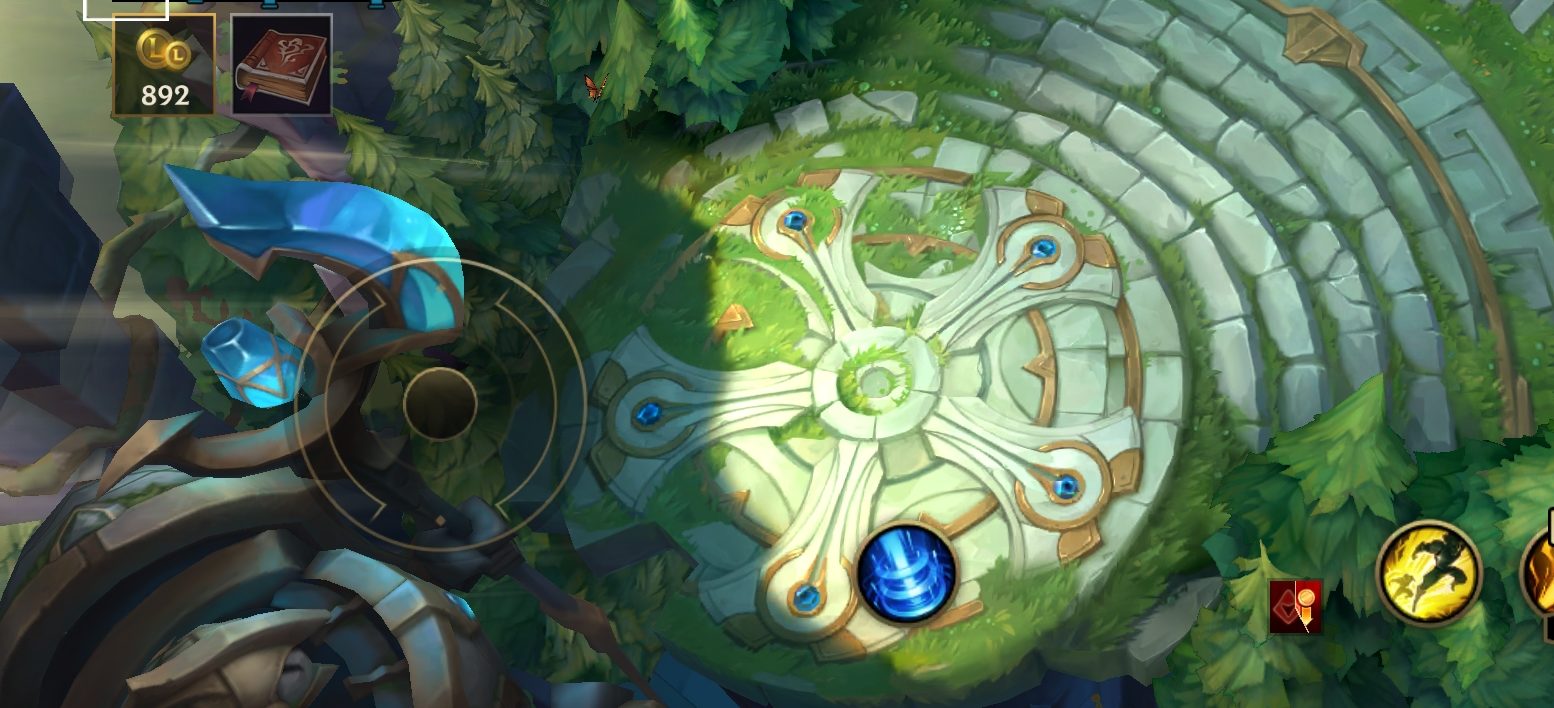
You should return to the base every now and then to heal and buy items.
To return to your base you will have to Recall, but be careful your ability can be interrupted if something attacks you.
Income and Items
Your main income will be gold from killing minions, killing the enemy champions, or from turrets.
You will have to spend this gold wisely to get an edge over your opponents.
The more gold you get the stronger you will be and it will be easier to win.
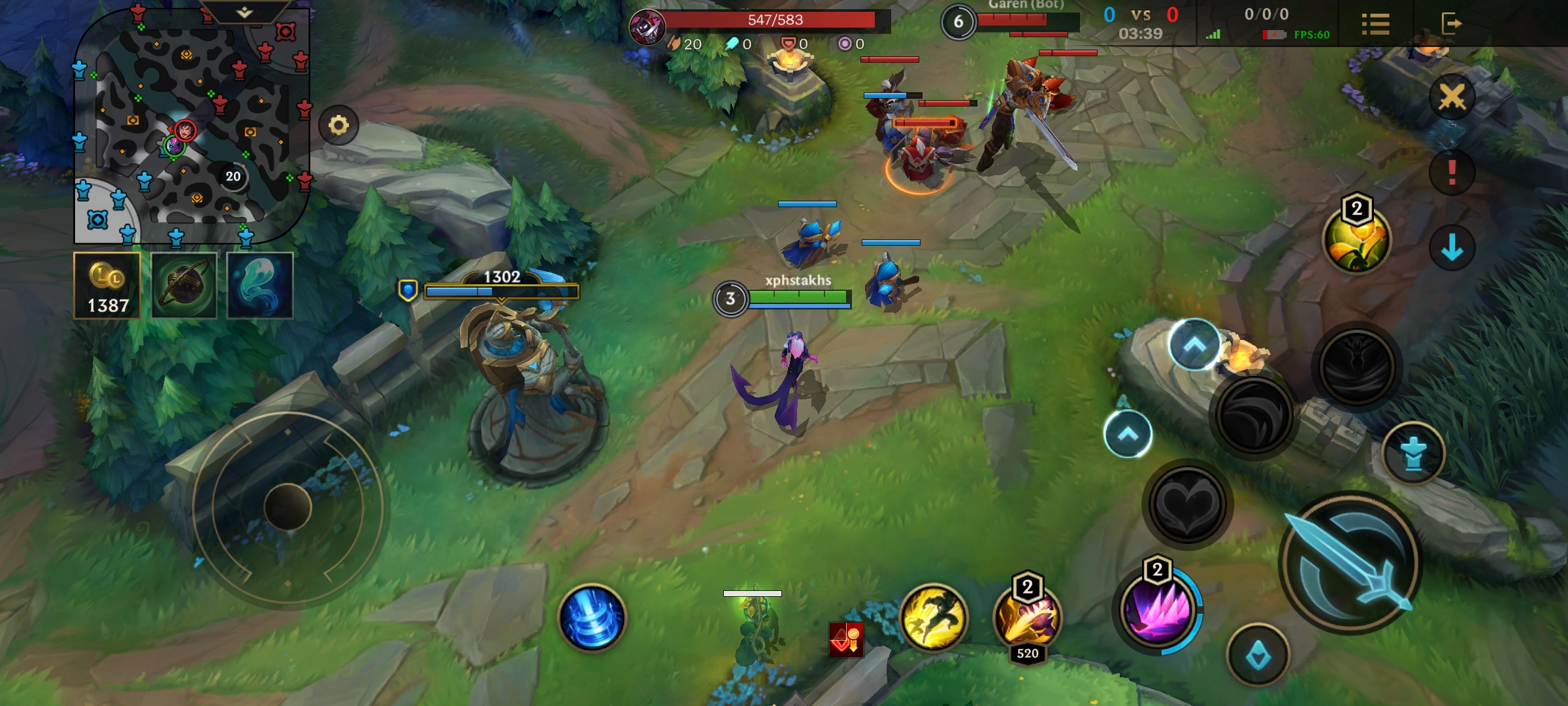
There are a variety of items in League of Legends: Wild Rift, you can buy damage, survivability, or utility items.
Each player has a limit of 6 items so use your slots thoughtfully.
4. Wild Rift Champion Basics
Champions are the most important thing in Wild Rift since they’re the only thing that’s 100% in a player’s control.
There are currently over 50 champions with each one being completely unique.
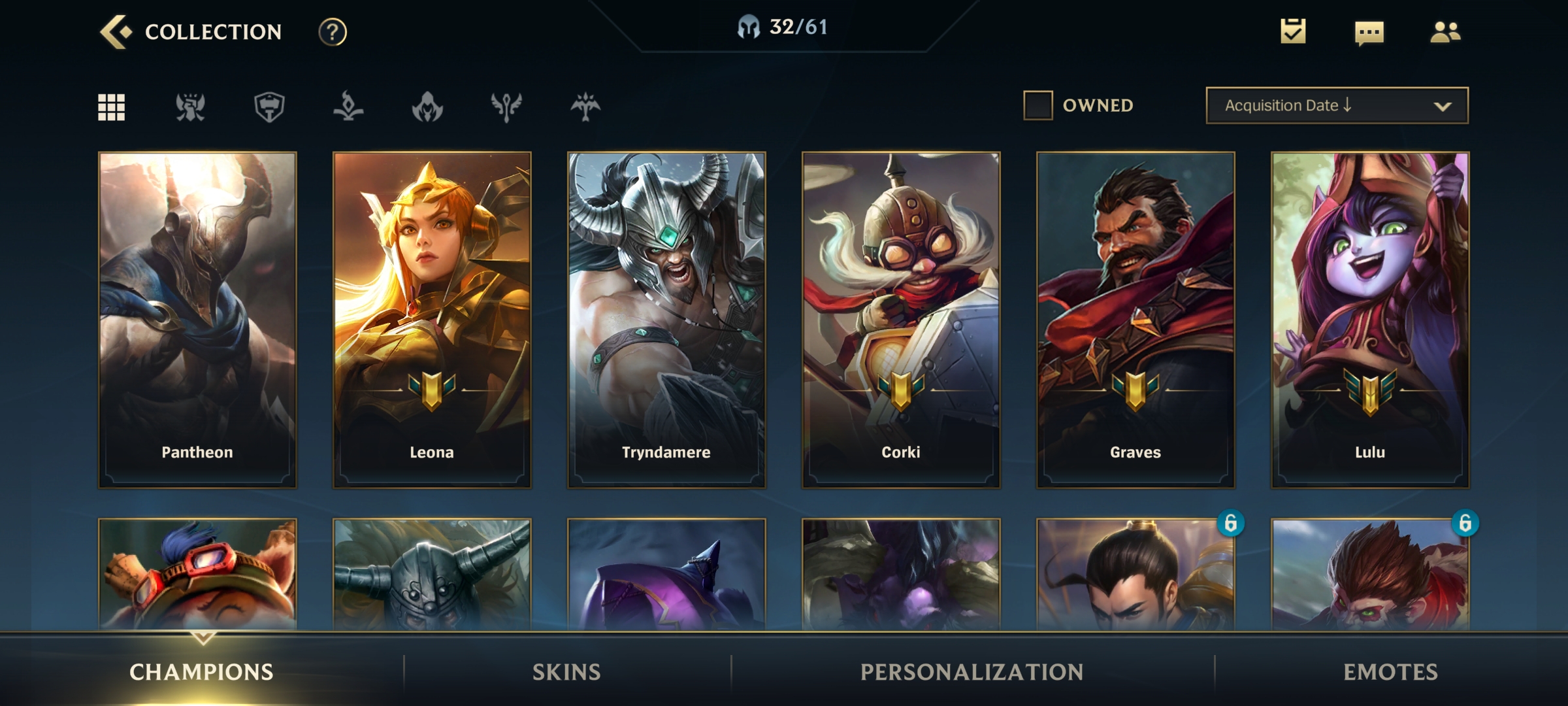
Some champions are very easy to play while others are very hard and will need time to learn them and play them properly. There is almost a champion for each playstyle and there are more coming into the game.
Auto-attacks and Abilities
Every champion in League of Legends: Wild Rift has auto-attacks, and you can use them if you press the attack button. You can just press it or drag it out and choose the target you want to attack.
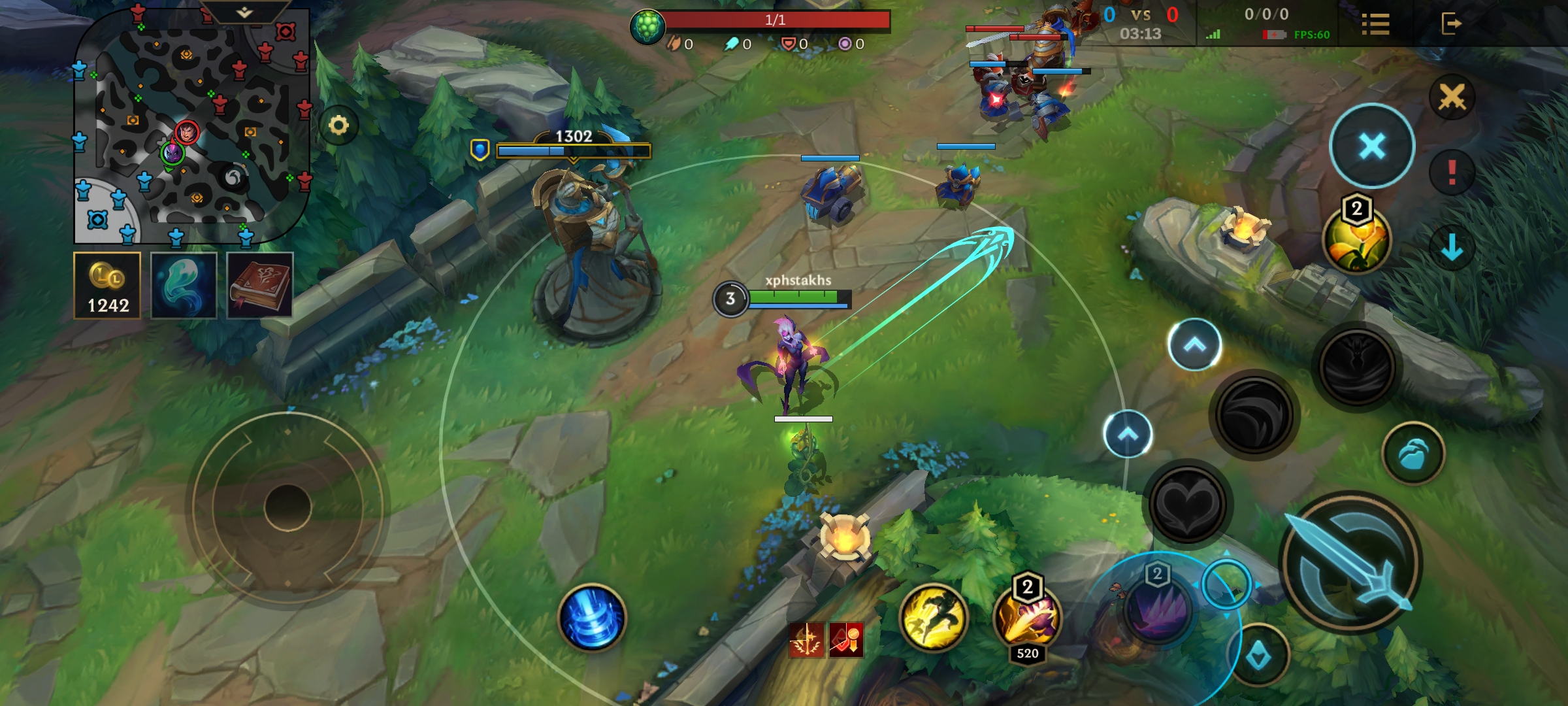
There are also 4 abilities that each champion has that are right next to your basic attack button. Every player has also access to two summoner spells. There are also item actives that can be bought as boots upgrades.
Champion Stats
For each champion in League of Legends: Wild Rift there are different stats and each champion benefits from different stats. Each stat shows how powerful or how tanky a champion can be.
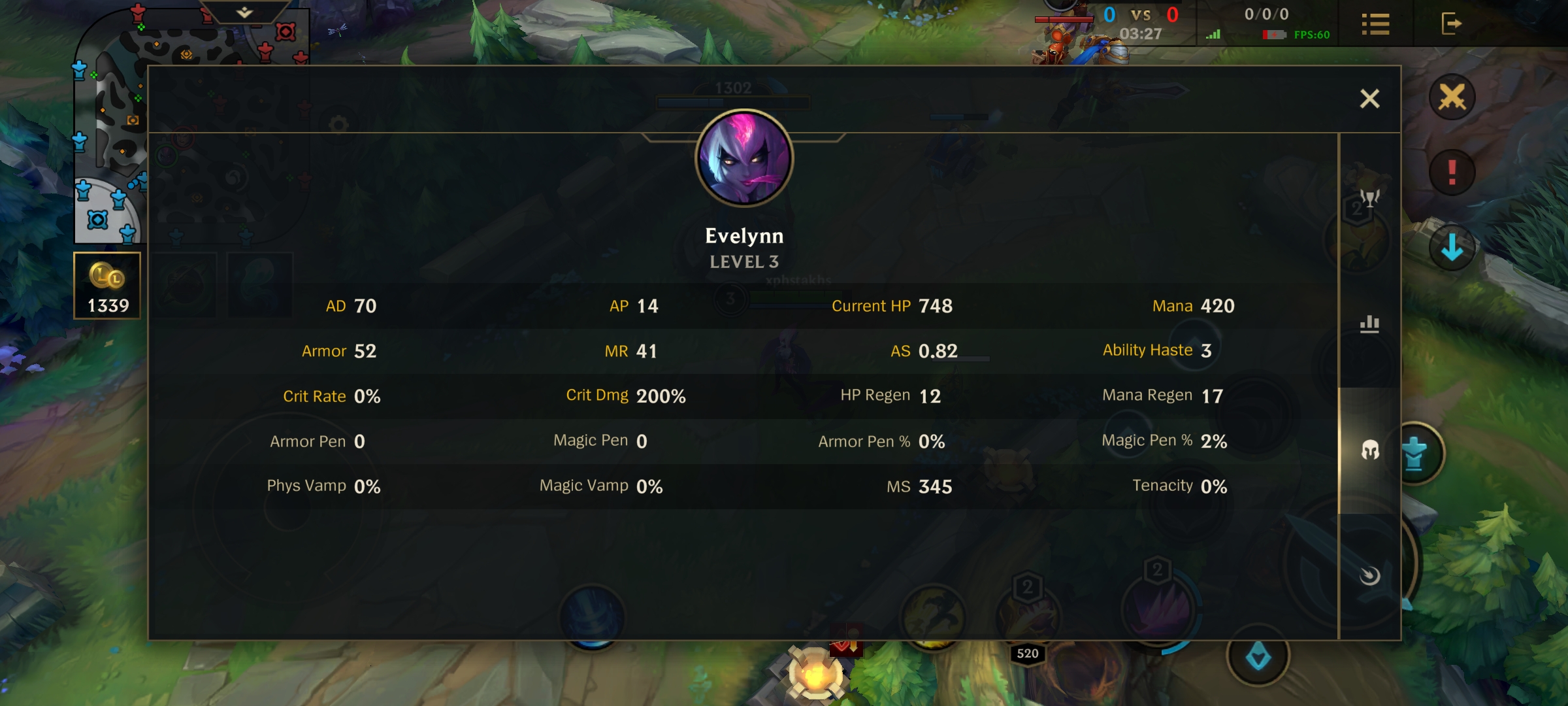
Here are the basics:
Health (indicated by a green bar)
- Health represents the amount of damage you can take before die and respawn in your fountain again
Ability Resources: Mana, Energy, and others
- Abilities cost resources in order to cast them, most champions use mana and energy
- The majority of champions, use mana some are able to gain mana back like Twisted Fate if he uses his blue card.
- Mana is indicated by a blue bar below the health bar and regenerates over time or with blue buff.
- Champions such as Akali, Kennen, and Lee Sin use energy.
- Energy is indicated by a yellow bar and also regenerates over time but at a much faster rate. These champions often have ways to get energy back as well, such as by auto-attacking.
- The tradeoff is that, unlike mana, you cannot increase the amount of energy you have through buying items.
- Other champions use other sources, such as their health and fury.
- Using health is straightforward, your champion basically loses an amount of health in order to cast their spell.
Attack Damage (AD)
- Attack damage, also known as physical damage, represents the damage dealt by basic auto-attacks.
- Depending on a champion, AD can also empower abilities.
- Numbers from abilities and items that refer to attack damage are displayed as orange.
Ability Power (AP)
- Ability power primarily makes your abilities and auto-attacks on turrets more powerful, however, AP can also strengthen some items and runes.
Armor
- Armor is a defensive stat that reduces the amount of physical damage a champion receives. Building it will help you survive against champions with a lot of attack damage.
Magic Resist (MR)
- Magic resist is the counterpart to armor that mitigates damage from ability power.
Attack Speed (AS)
- Attack speed represents how fast your champion auto-attacks.
Ability Haste (AH)
- Abilities have “cooldowns” representing how long it will be before you can cast it again. Items that give you ability haste allow you to cast abilities more often.
Critical Strike Chance
- This stat shows your chance of landing a critical strike – critical strikes cause your auto-attacks to deal double its damage.
- For example, if you have 50% crit chance, your attacks will likely crit 50% of the time. If you have a 100% crit chance, they will crit every time.
Movement Speed (MS)
- Movement speed represents how fast your champion moves around the map. This can be increased with abilities and items such as boots.
Experience and Leveling up a champion
In League of Legends: Wild Rift you start at level 1 and you end up level 15. You gain experience by farming minions, jungle camps, or getting kills/assists.
Being near a kill without participating in it also gives you experience.
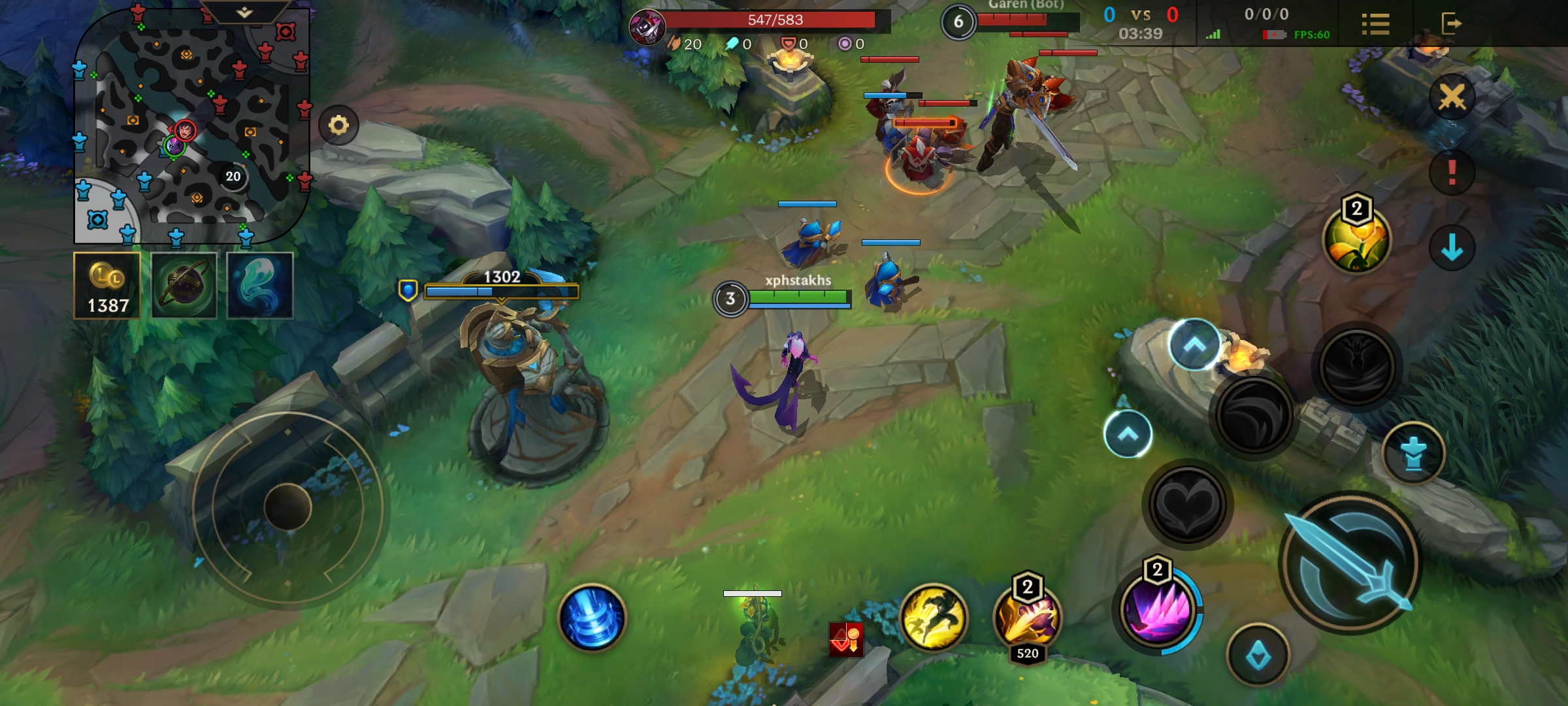
With experience, you gain levels and you can start adding points to your abilities to make them more powerful. Your champion will get stronger with each level because your gain stats for every level you gain.
Summoner Spells
There are not only abilities in League of Legends: Wild Rift but also Summoner Spells. Every player can choose in two Summoner Spells at champ select.
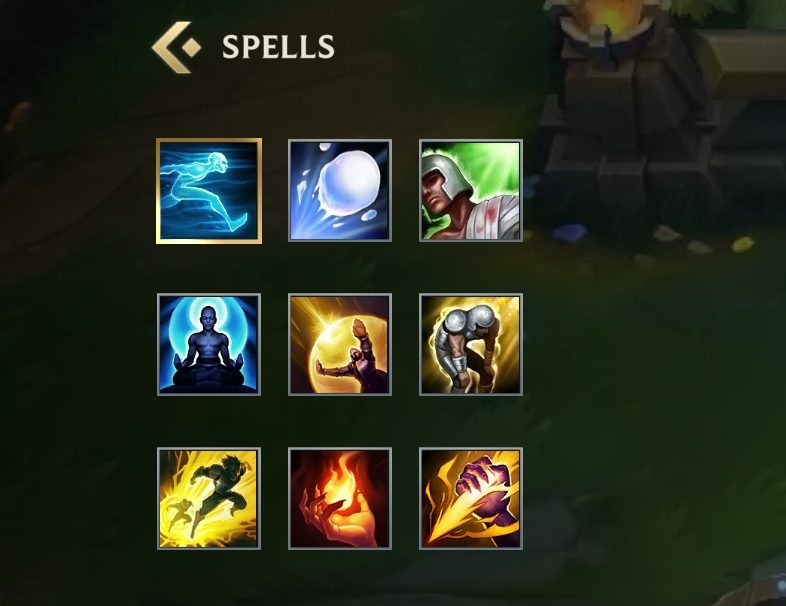
You have a variety of SummonerSpells you can choose from and play the game. In the following section, we will show you what each Summoner Spell does:
Barrier (90-second cooldown):
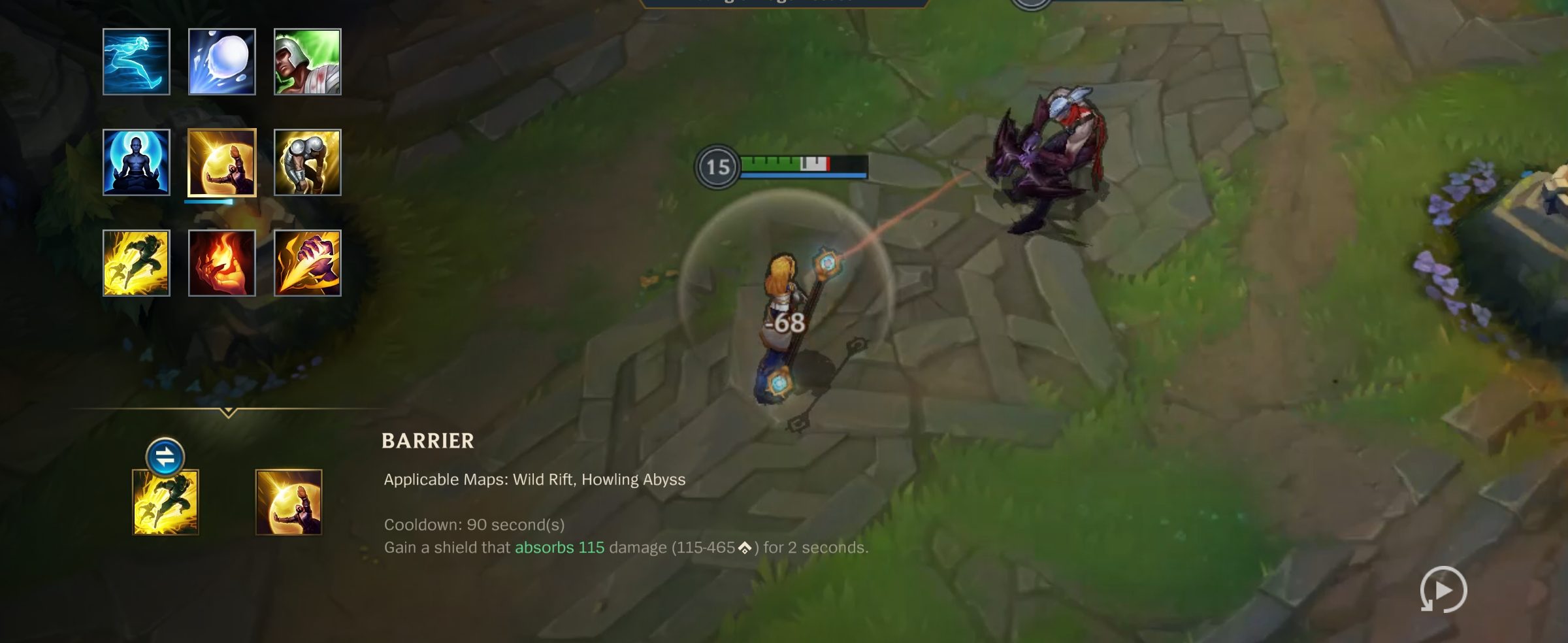
- Gain a shield that absorbs 115 − 465 (based on level) damage for 2 seconds.
Exhaust (105-second cooldown):
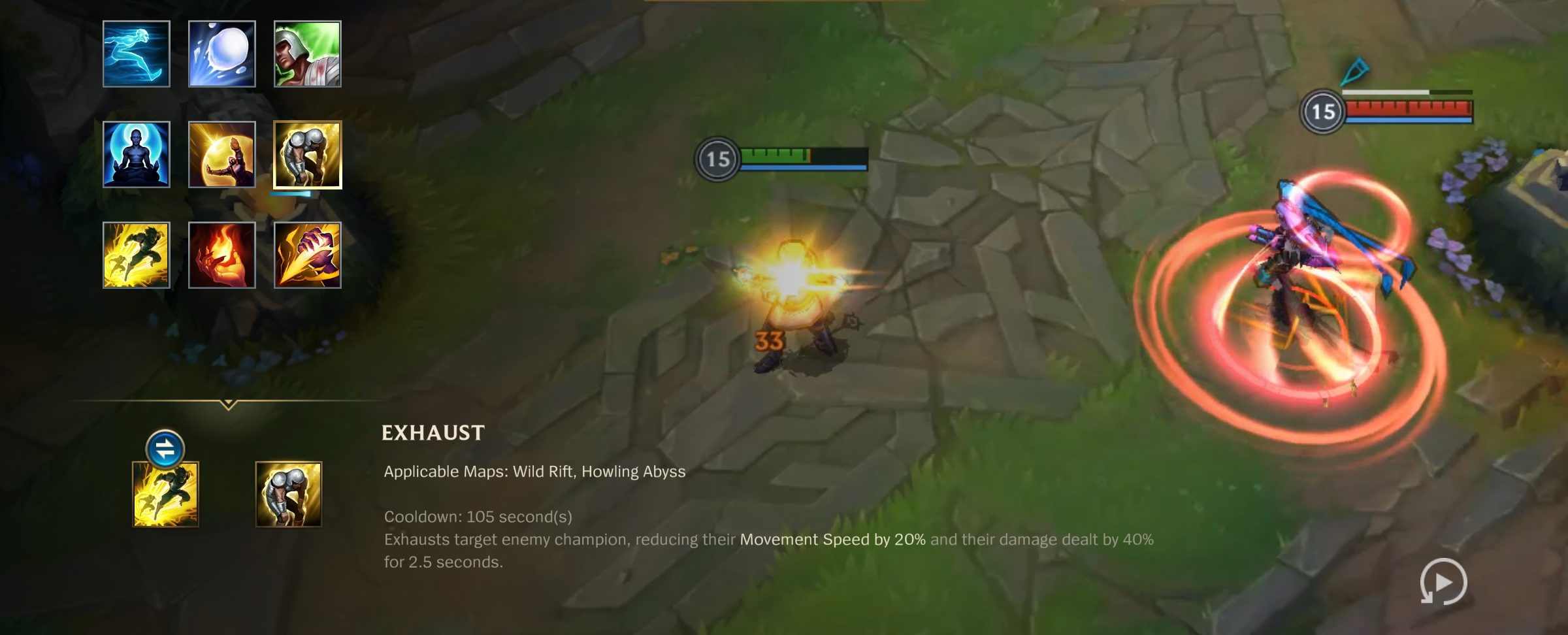
- Exhausts target the enemy champion, reducing their movement speed by 20% and their damage dealt by 40% for 2.5 seconds.
Flash (150-second cooldown):
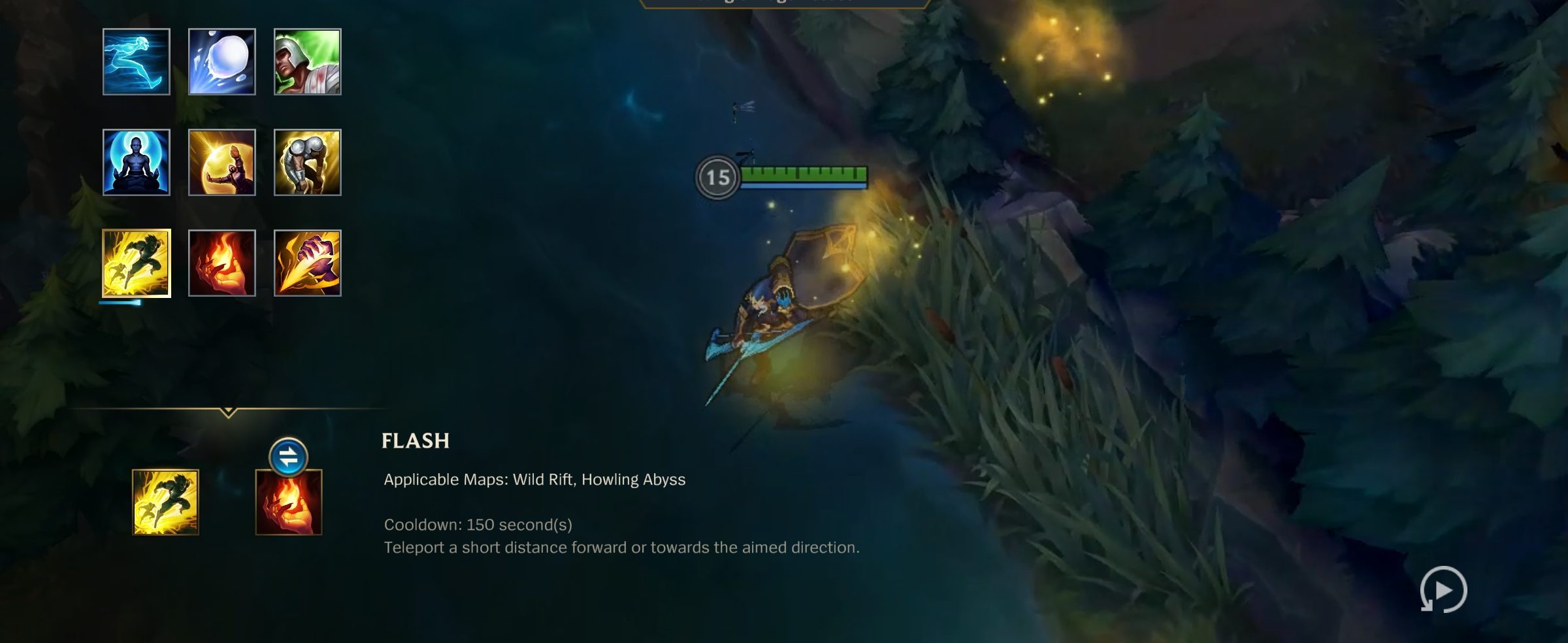
- Teleport a short distance forward or towards the aimed direction.
Ghost (90-second cooldown):
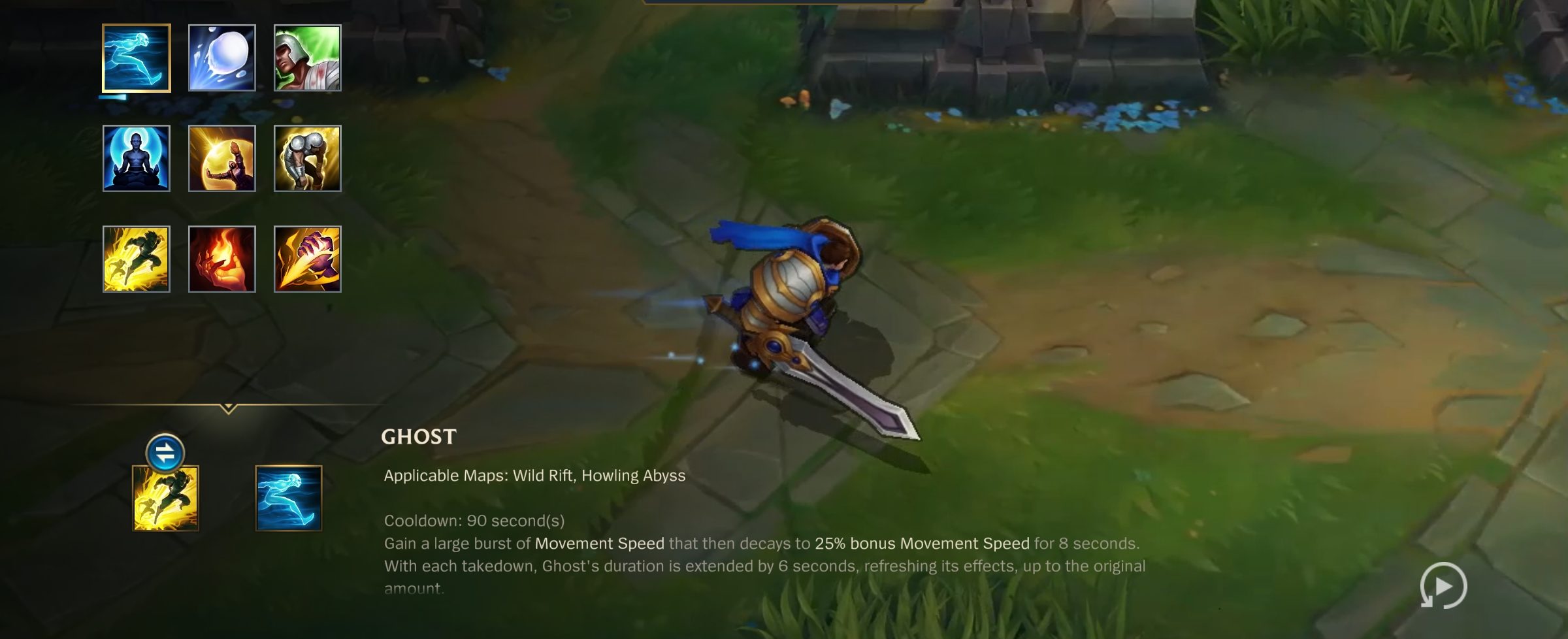
- Gain a large burst of movement speed that decays to 25% bonus movement speed for 6 seconds.
Heal (120 second cooldown):
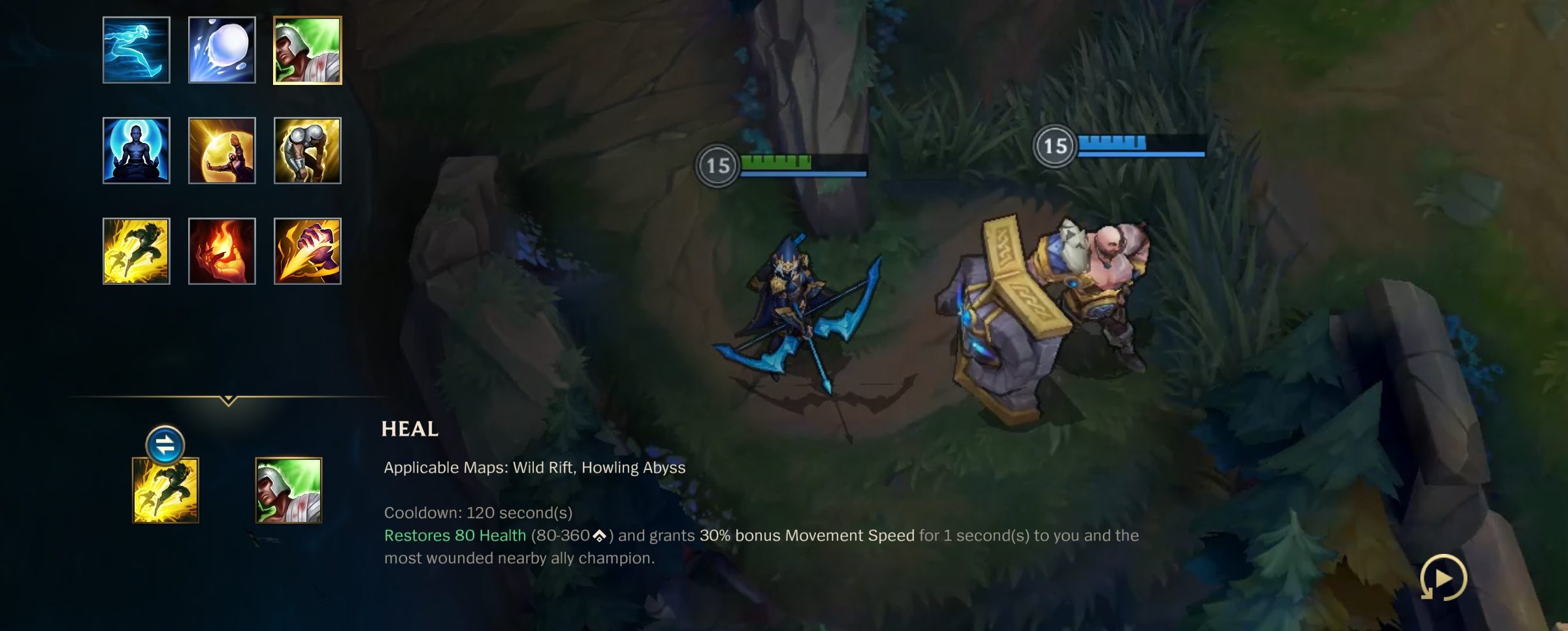
- Restore 80 − 360 (based on level) health and grants 30% bonus movement speed for 1 second to you and the most wounded nearby ally champion. Healing is halved for champions recently affected by Heal.
Ignite (90 second cooldown):
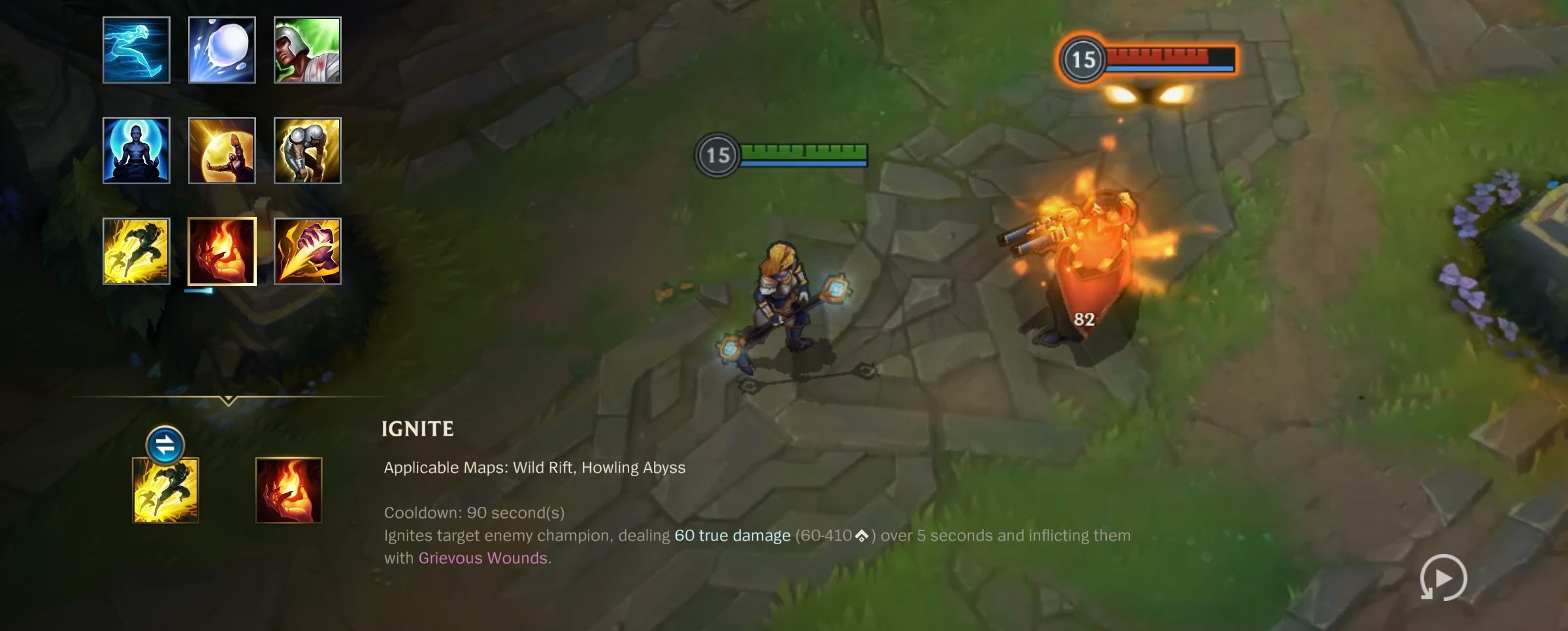
- Ignites target enemy champion, dealing 60 − 410 (based on level) true damage over 5 seconds and inflicting them with Grievous Wounds Grievous Wounds, reducing healing effects by 50% (90 second cooldown).
Smite (10 second cooldown):
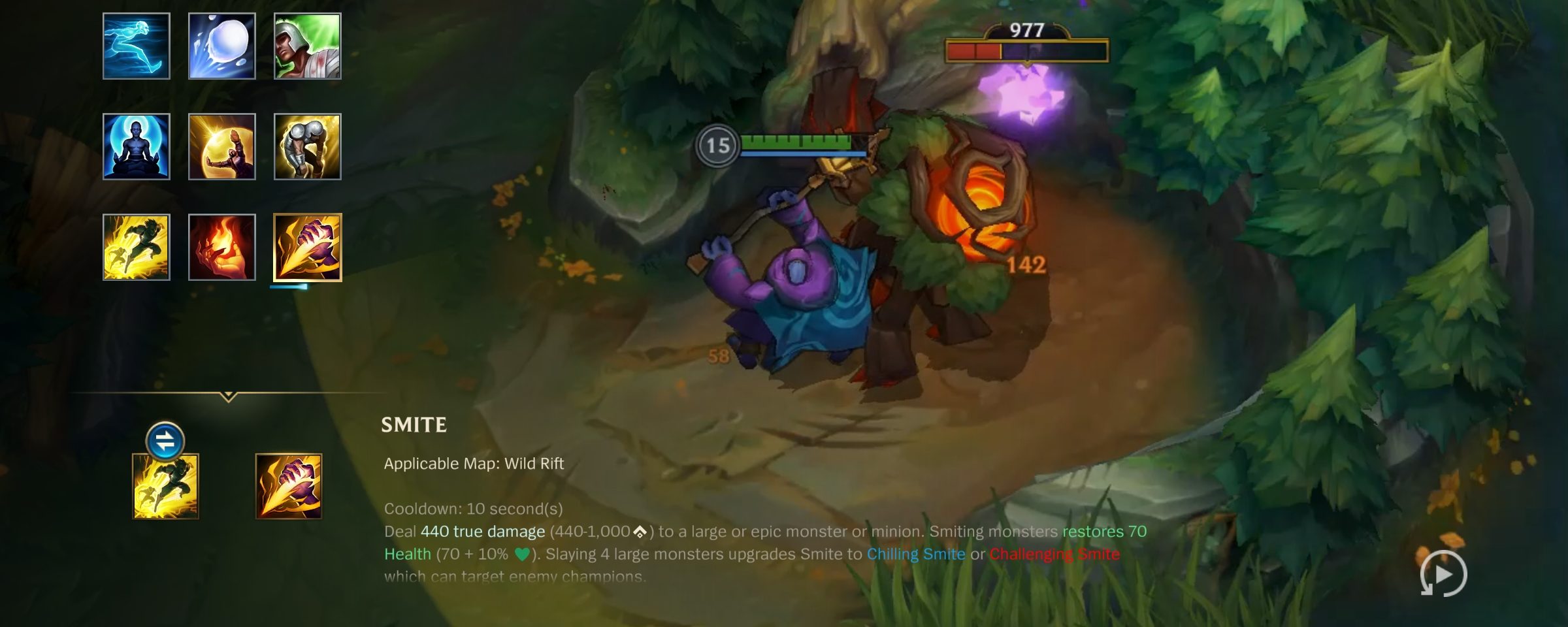
- Deal 440 − 1000 (based on level) true damage to a large or epic monster or minion (10 second cooldown). Smiting monsters restore 70 (+ 10% maximum health) health.
Runes
In League of Legends: Wild Rift, runes give your champion’s particular beneficial attributes and abilities that can help you play toward certain playstyles.
Each champion needs a specific rune path to excel at their maximum with some deviations.

In this section, we will provide you with all the information about the runes in Legends: Wild Rift:
Keystones
Electrocute(25 seconds cooldown):
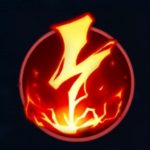
- PASSIVE: Basic attacks and abilities generate stacks on enemy champions hit, up to one per attack or cast. Applying 3 stacks to a target within a 3 second period causes them to be struck by lightning, dealing them 30 − 184 (based on level) (+ 40% bonus AD) (+ 25% AP) Adaptive damage.
- ADAPTIVE DAMAGE: Deals either physical or magic damage depending on your bonus statistics, defaulting based on the origin of the effect.
Aery:
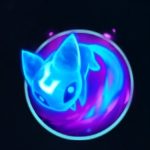
- PASSIVE: Basic attacks and abilities against an enemy champion signal Aery to dash to them, dealing 10 − 60 (based on level) (+ 20% bonus AD) (+ 10% AP) Adaptive damage. Healing, shielding, or buffing an ally signals Aery to dash to them, Hybrid resistances shielding them for 20 − 120 (based on level) (+ 40% bonus AD) (+ 20% AP) for 2 seconds.
- Aery lingers on the target for 2 seconds before flying back to the user, and cannot be sent out again until she returns. Aery is initially very slow, but gradually accelerates, and can be picked up by moving near her.
- ADAPTIVE DAMAGE: Deals either physical or magic damage depending on your bonus statistics, defaulting based on the origin of the effect.
Conqueror:

- PASSIVE: Basic attacks and abilities generate stacks of Conqueror on enemy champions hit, up to one per attack or cast. Each stack of Conqueror lasts 8 seconds and grants 2 − 6 (based on level) bonus Attack Damage or 4 − 12 (based on level) Ability Power (Adaptive), stacking up to 5 times, for a maximum of 10 − 30 (based on level) bonus Attack Damage or 20 − 60 (based on level) Ability Power (Adaptive).
- When fully stacked, deal 10% bonus Adaptive damage to champions.
- ADAPTIVE DAMAGE: Deals either physical or magic damage depending on your bonus statistics, defaulting based on the origin of the effect.
Fleet Footwork:

- UNIQUE – ENERGIZED: Moving and basic attacking generate Energize stacks, up to 100.
- FLEET FOOTWORK: When fully Energized, your next basic attack heals you for 15 − 85 (based on level) (+ 30% bonus AD) (+ 30% AP) and grants 20% bonus movement speed for 1 second. Against minions, the healing is (Melee role 100% / Ranged role 30%) effective.
Grasp of the Undying:
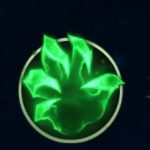
- PASSIVE: Entering combat generates one stack every second for the next 3 seconds. Additional stacks may be generated by re-entering combat after 2 seconds. After reaching 4 stacks, your next basic attack within 6 seconds against an enemy champion consumes all stacks to deal 4% of your maximum health in bonus magic damage, restore 2% of your maximum health, and permanently grant 5 bonus health. The empowered attack duration refreshes whenever going in combat.
- On ranged champions, all effects are reduced by 60%.
Aftershock(35 seconds cooldown):
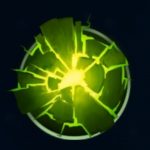
- PASSIVE: Immobilizing an enemy champion grants a static 50 (+ 50% bonus armor) bonus armor and 50 (+ 50% bonus magic resistance) bonus magic resistance for 2.5 seconds.
- After the duration, you release a shockwave that deals 12 − 110 (based on level) (+ 4% of your maximum health) magic damage to nearby enemies.
Font of Life:

- PASSIVE: Slowing or Stun immobilizing an enemy champion marks them for 4 seconds.
- Allied champions who basic attack marked enemies heal for 3% of your maximum health over 2 seconds.
Kleptomancy(25 seconds cooldown):

- PASSIVE: After using an ability, your next ability hit or basic attack against an enemy champion will grant you a random item effect.
Paths
Domination:
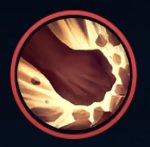
- Brutal: PASSIVE: Gain 7 bonus Attack Damage and 2% bonus-armor penetration, or 14 Ability Power and 2% bonus-magic penetration (Adaptive).

- Gathering Storm: PASSIVE: Every 2 minutes, gain 2 bonus Attack Damage or 4 Ability Power (Adaptive).
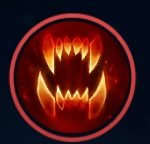
- Hunter-Vampirism:PASSIVE: Gain 2% Physical Vamp or 2% Magical Vamp (Adaptive). Unique champion takedowns grant 2 bonus Attack Damage with 1% Physical Vamp or 4 Ability Power with 1% Magical Vamp up to 7% Physical Vamp and 10 bonus Attack Damage or 7% Magical Wamp and 20 Ability Power at 5 stacks (Adaptive).
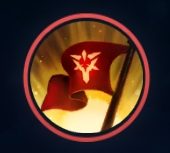
- Triumph: PASSIVE: Champion takedowns restore 10% missing health. Deal 3% increased damage to enemies below 35% health.
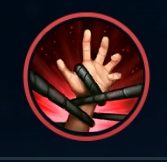
- Weakness: PASSIVE: Slowing or immobilizing an enemy champion marks them for 5 seconds, while marked they take 5% increased damage.
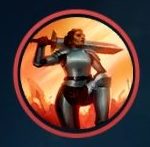
- Champion: PASSIVE: Gain 10% increased damage against champions. Lose 5% each time you die until the bonus disappears.
Resolve
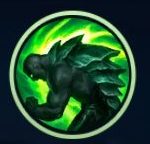
- Backbone: PASSIVE: Gain 10 bonus armor or 10 bonus magic resistance, based on whichever stat you have less of.

- Conditioning: PASSIVE: Gain 8 bonus armor and 8 bonus magic resistance after 5 minutes of game time.

- Hunter – Titan: PASSIVE: Gain 20 maximum health. Unique champion takedowns grant an additional 20 maximum health and 4% tenacity up to 120 maximum health and 20% tenacity at 5 stacks.

- Regeneration: PASSIVE: Every 3 seconds, regenerates 2% missing health or 2% missing mana, based on whichever percentage is lower.

- Loyalty: PASSIVE: Gain 2 bonus armor and 5 bonus magic resistance. Your closest ally champion gains 5 bonus armor and 2 bonus magic resistance, which can be stacked.

- Spirit Walker: PASSIVE: Gain 50 maximum health and 20% slow resistance.
Inspiration
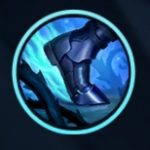
- Pathfinder: PASSIVE: When out-of-combat, gain 8% bonus movement speed in brush, jungle and river.

- Mastermind: PASSIVE: Deal 10% bonus true damage to epic monsters and turrets. Earn an additional 100 gold Gold 100 gold and 500 XP upon taking or assisting in taking these objectives.

- Hunter – Genius:PASSIVE: Gain 2.5 ability haste. Unique champion takedowns grant 2.5 ability haste up to 15 at 5 stacks.

- Sweet Tooth: PASSIVE: Increases Honeyfruit healing by 25%, each fruit eaten also provides 20 gold Gold 20 gold.

- Pack Hunter: PASSIVE: While near ally champions, gain 2% bonus movement speed. For each unique ally you participate in a takedown with, you gain 50 gold and the ally gains 50 gold.

- Manaflow Band:PASSIVE: Hitting an enemy champion with an ability or empowered attack permanently increases your maximum mana by 30, up to 300 mana.
The Adaptive Force in Wild Rift seems to be different from its League of Legends’ variant: 1 point of Adaptive Force provides 0.5 bonus AD or 1 AP.
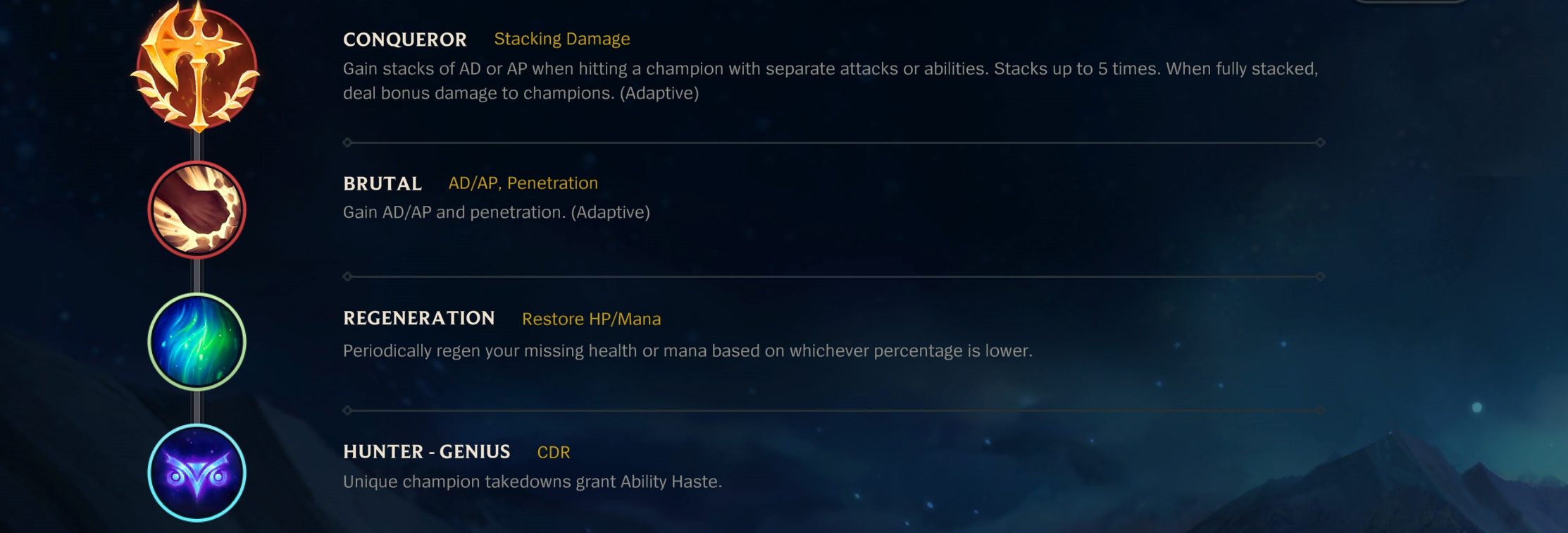
When you are choosing your runes, you have a single tree to choose 4 different choices including keystone.
The first slot is the domination slot the second one is the resolve one and the third one is the Inspiration. Understanding which runes to choose in every situation is very hard for a beginner and even for experienced players.
5. The Five Wild Rift Roles
In League of Legends: Wild Rift there are five different roles like in League of Legends. The five roles are Top, Jungle, Mid, ADC, and Support.
Since there is no role selection right now in Wild Rift you will have to adapt every game since there are different role popularity.

If you are a new player we suggest you try every role in some games to see which one fits you the best. Once you find the best role that suits you try to main this role.
But keep in mind that you will have to play all roles since there isn’t role selection.
What is a team comp?
Since League of Legends: Wild Rift is a team-based game where 5 players compete against the other 5 players the champion select is very important. If you use your team to combine the abilities you can win the game.
An area-of-effect (AoE) team comp is the best one you can have because you can combine all your abilities at the correct time to delete a whole team.
A skirmisher comp is Skirmish team comps utilizing champions that have high mobility and like to fight in messy fights from multiple angles(assassins). This comp is also very effective if you can dodge the AoE spells.
If you are a new player don’t worry about team comps since it’s very hard to pull off an organized team fight even in higher ranks, since there is no communication in a game like League of Legends: Wild Rift.
6. The Map, Fog of War, and Vision Control
In League of Legends: Wild Rift it is very important to play with and against the fog of war. You can’t see everything like in other mobile game MOBA’s and it’s harder to make decisions. The fog of war is shown on the minimap as a darkened area.
You have to be careful when you walk around walking into the darkness without any vision. You can also use the fog of war to attack from the dark without any anticipation from the enemy team.
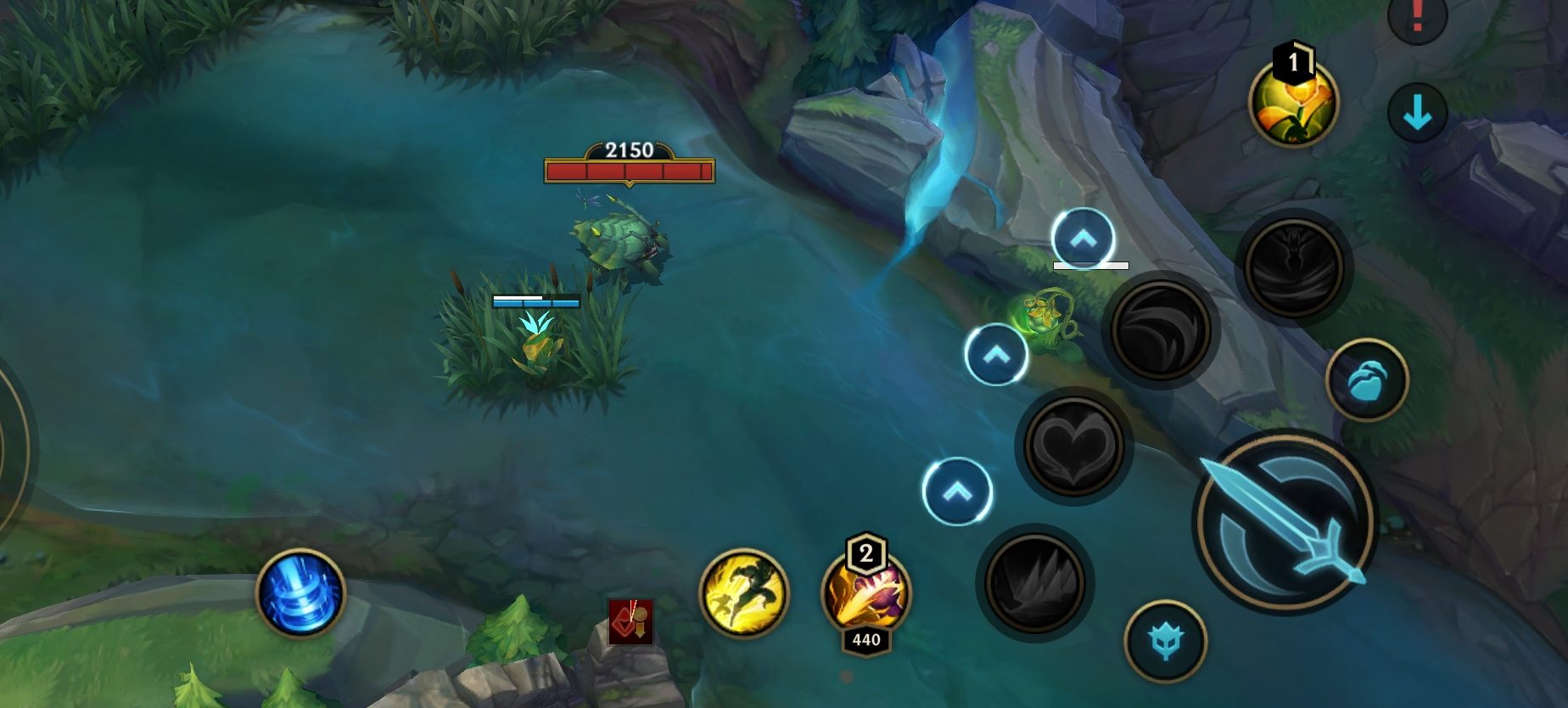
Your allied champions, structures, and wards provide vision. At the beginning of the match, you get an item called Warding Totem that can stack up to two wards. Wards last a limited time and vanish after that.
Clearing wards is very important, that’s why support’s and junglers should always change their Warding Totem’s to an Oracle Lens.
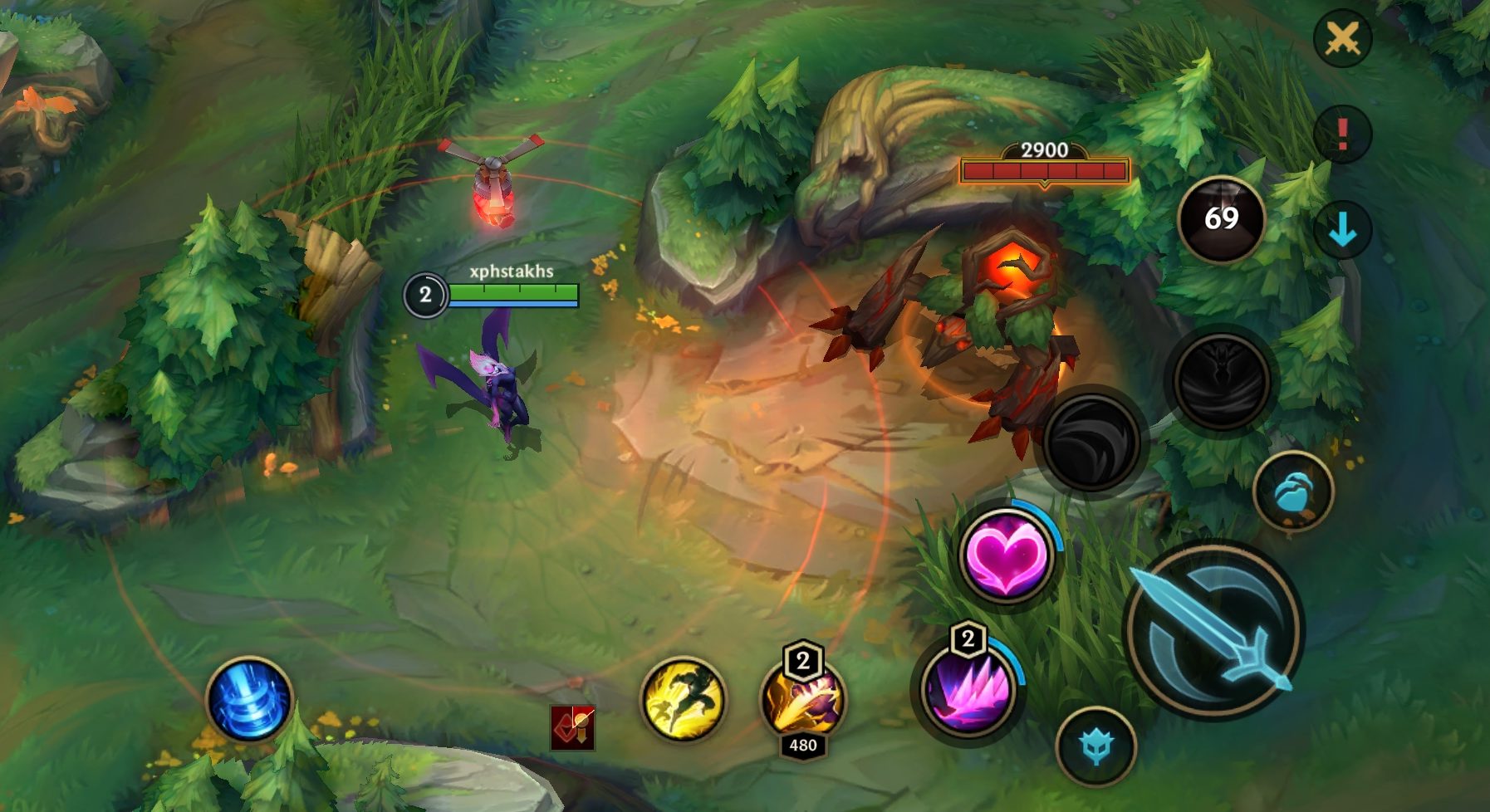
The Oracle Lens is a lamp that appears over your champion while you are walking and showing you the enemy wards. It also negates the vision of the enemy ward if you reveal it.
The River, Jungle, and Camps
In between the lanes, there is a river that runs across the map, a lot of fights happen there since players use it to go up and down the map and where all the big objectives are.
In the jungle, there are camps that can be cleared by anyone but preferably by junglers.
Those camps give gold and experience but more experience to players that use Smite as a Summoner Spell. They spawn over time and have a cooldown till they respawn.
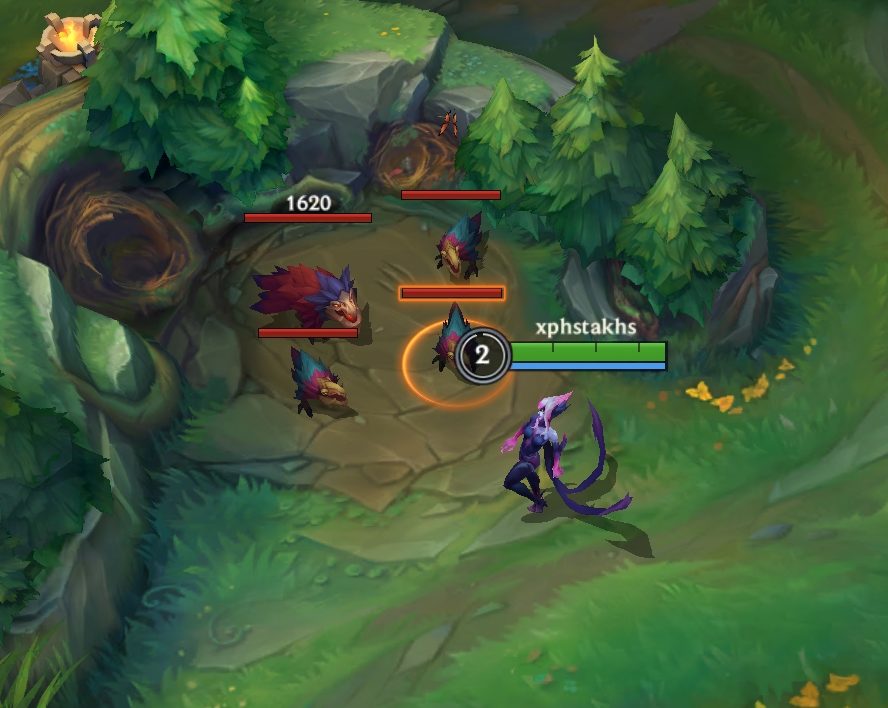
The jungle also has buffs. It is good to secure those buffs to have an advantage over the enemy team.
If you take down the Blue Sentinel you get the so-called blue buff that restores mana and health over time and gives you 15 ability haste. But if you slay Red Brambleback your auto attacks deal more damage and slow them.
Jungle Plants
As you travel around the jungle you will notice interactive plants that spawn and can be used. If you use them correctly you can gain a big advantage.
Scryer’s Bloom
Scryer’s Bloom will create a cone of cleared vision in the direction you hit it for a short amount of time.
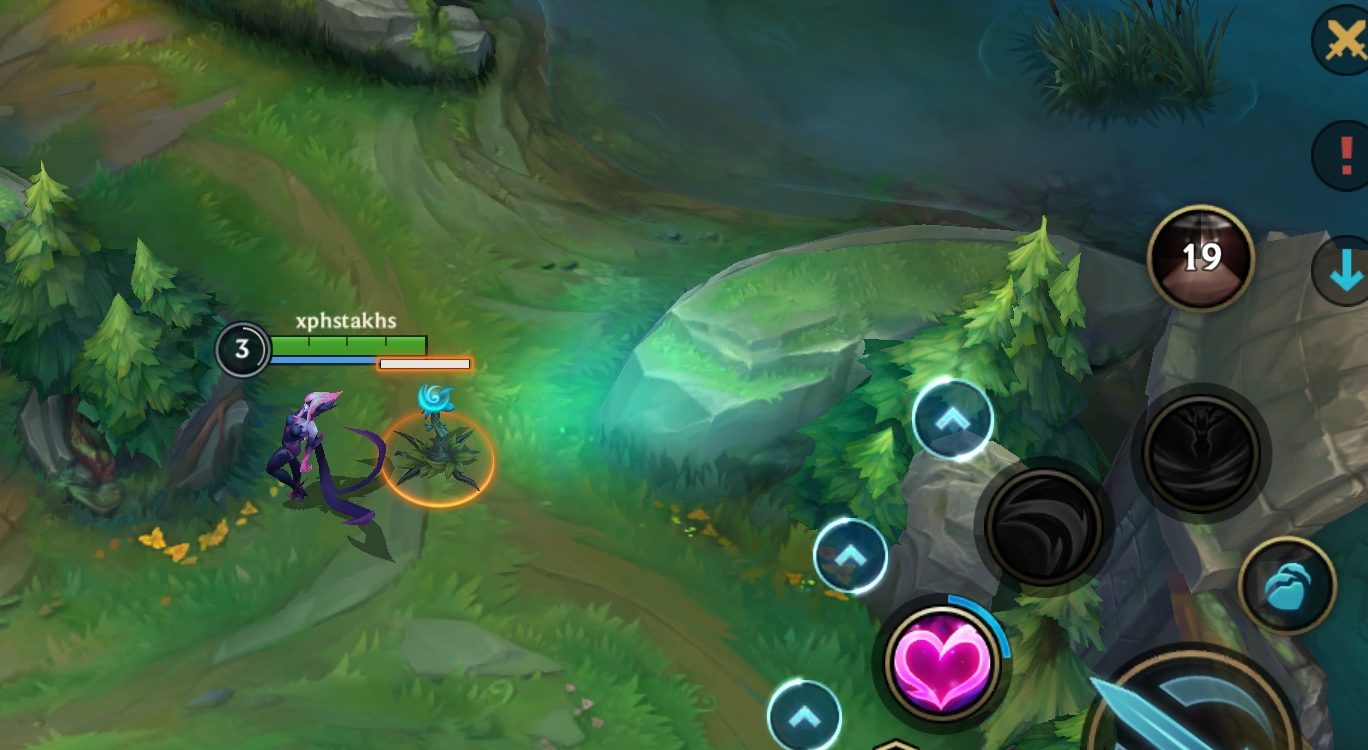
This plant is very useful since you can reveal the enemy champions and track them down. It can also be used to reveal wards permanently so you can know where to walk without being noticed or even clear them.
Honeyfruit
This plant spawns around the river and in every lane. Once you attack them they pop and leave 3 dots on the ground you can walk over and gain hp and mana.
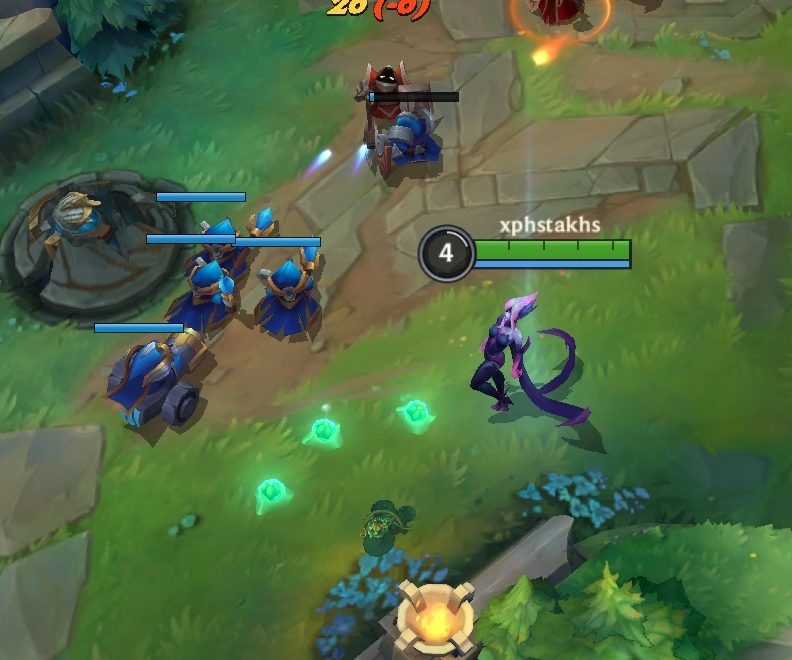
It is very important to use them correctly in lane because it is the only source of hp and mana regeneration you have. The one in the river isn’t that important but it can save your life from time to time.
The Blast Cone
The red plants in the Jungle are called Blast cones. They can cause a champion to fly to a chosen direction if autoattacked.
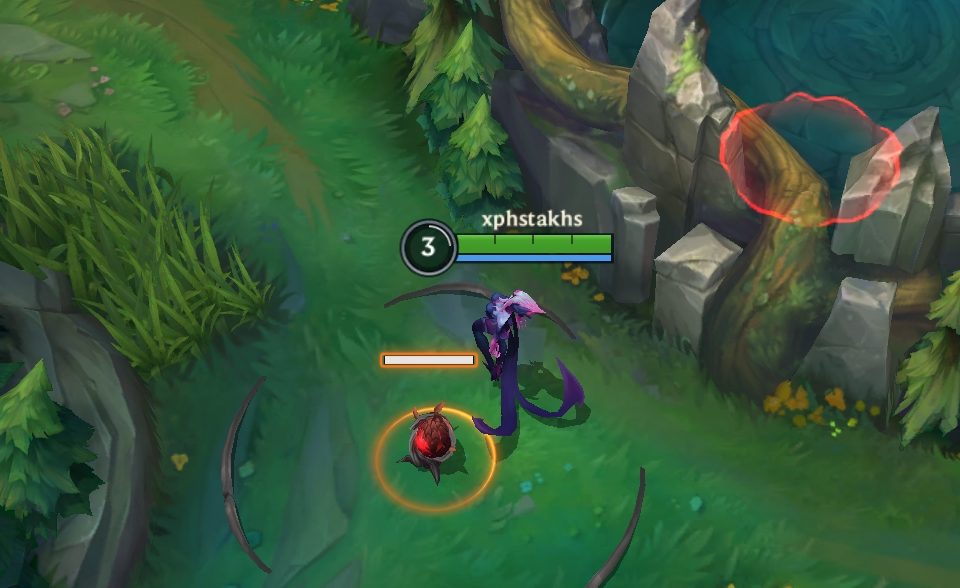
This plant can be used to jump over walls. For example, if you try to escape from the enemies or try to get to your next camp.
The Scuttle Crab
In the river you will often see a neutral monster that walks up and down, this is called Scuttle Crab.
Slaying the Scuttle Crab will give vision for your team and an area that gives movement speed to yourself and your team every time they walk over it.
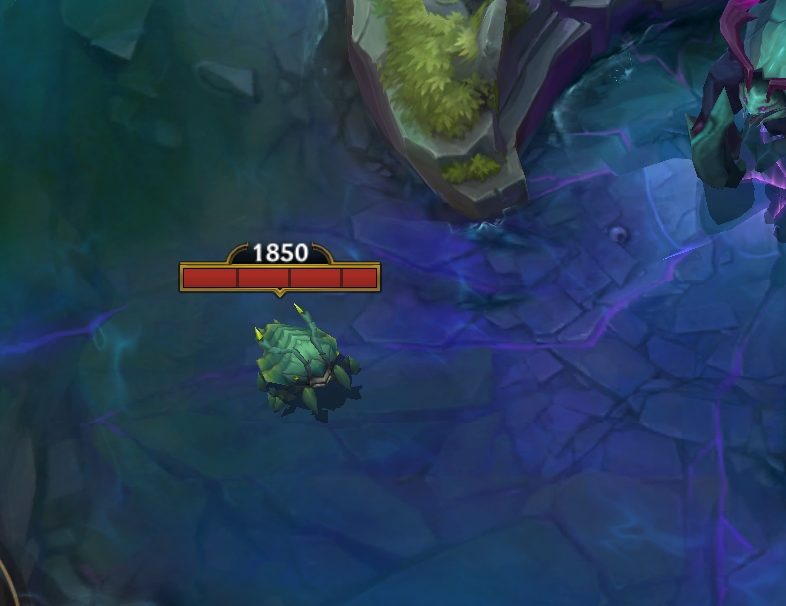
It is very easy to kill, but you will have to be careful since both teams will try to take it down because it grants free vision in the river. If you are playing jungle prioritize this camp very high and try to kill it as soon as it spawns and if you are a laner be willing to leave your lane to help your jungler.
Elemental Dragons
Here are their names, color, and their effect:
- Cloud Drake (white) = Grants 7.5% bonus movement speed, doubled to 15% when out-of-combat.
- Infernal Drake (red) = Grants 8% increased damage.
- Mountain Drake (brown) = Grants 6% of maximum health as a shield after 5 seconds of not taking damage.
- Ocean Drake (blue) = Grants 8% Physical Vamp and Magical Vamp.
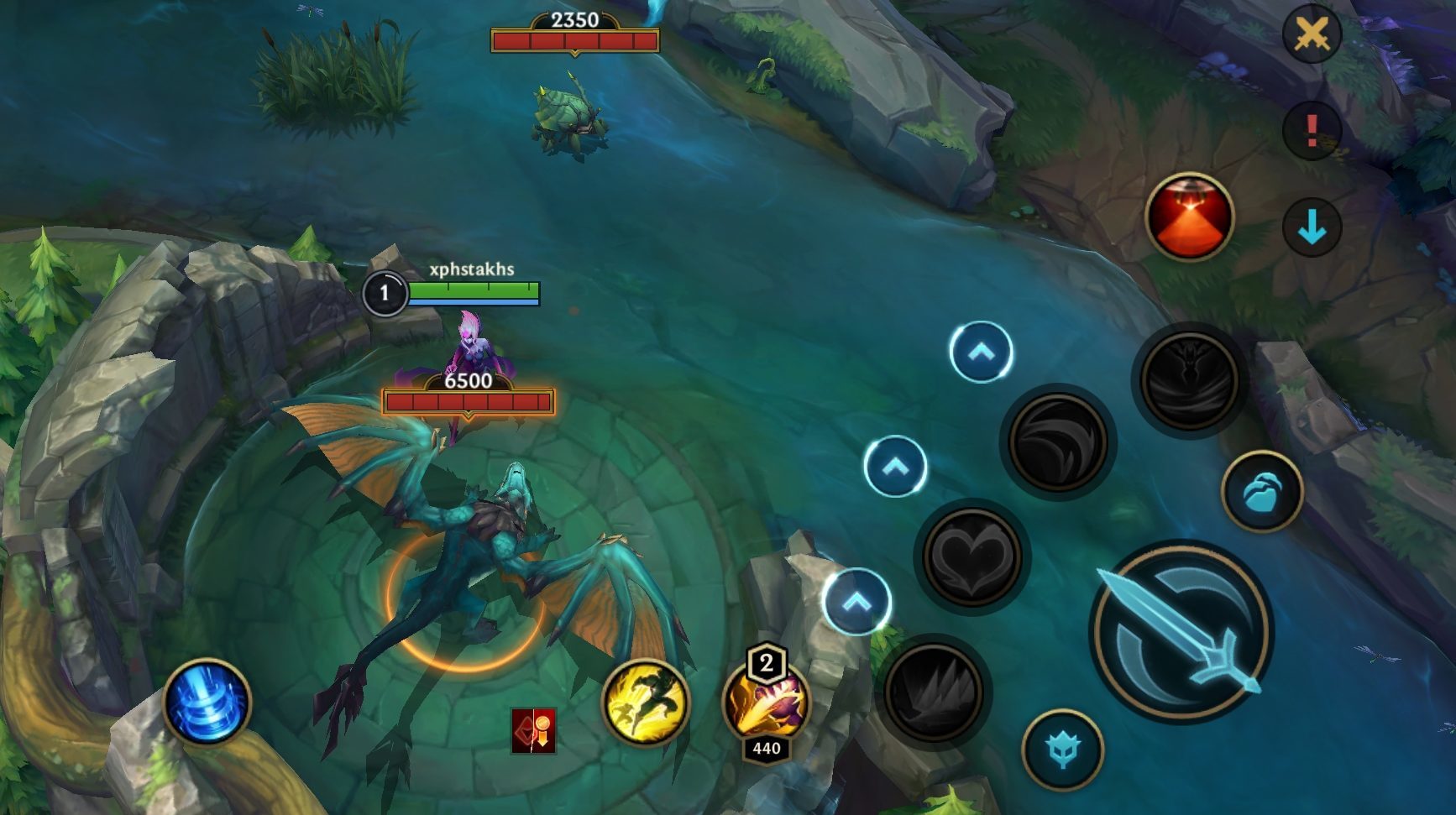
There is 8 Dragons total in Wild Rift; early in game 4 Ocean, Infernal, Mountain, and Cloud Dragons each have a random chance to spawn and, when slain by your team, you and your teammates will receive a permanent buff. First Dragon Spawns at 4:00.
The Elder Dragon
The Elder Dragon is also known as Elder drake spawns after players have slain at least 4 Elemental the game will begin to spawn Elemental Elder Dragons, which grants even stronger buffs.
Here are their names, color, and their effect:
- Elder Cloud (white) = Grants 11.25% bonus movement speed, doubled to 22.5% when out-of-combat.
- Elder Infernal (red) = Grants 12% increased damage.
- Elder Mountain (brown) = Grants 9% of maximum health as a shield after 5 seconds of not taking damage.
- Elder Ocean (blue) = Grants 12% Physical Vamp and Magical Vamp.
- Elder Bonus Buff=Attacks burn enemies dealing true damage.
This makes the elder the best objective on the whole map. Once you get the Elder drake the chances of you winning are very high.
Rift Herald
The Rift Herald is used to speed up the game, and when using the Rift Herald, players can destroy enemy towers early in the game. Rift Herald Spawns at 6:00 (Can only be slain ONCE).
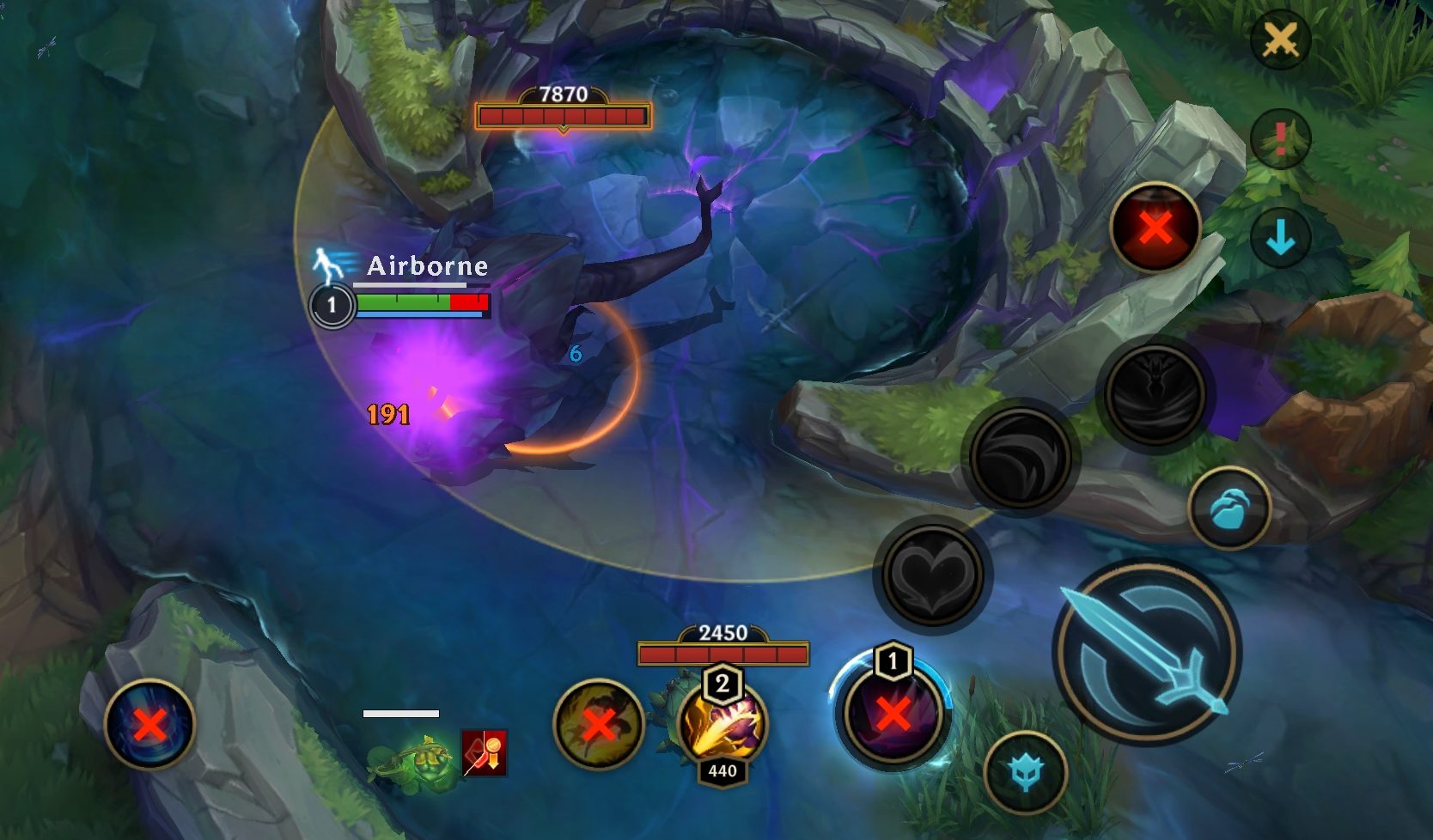
The Rift Herald will drop an Eye of the Herald buff, which can be picked up and used to summon the Rift Herald to ram enemy Tower to inflict a huge amount of damage within Range to get the first tower.
Baron Nashor
Baron Nashor Buff allows players to push into the enemy base and destroy the enemy nexus with powered up lane minions. You will need multiple members to slain the Baron. The Buff you gain is called the Hand of Baron. This Buffs up the minions and gives your more damage.
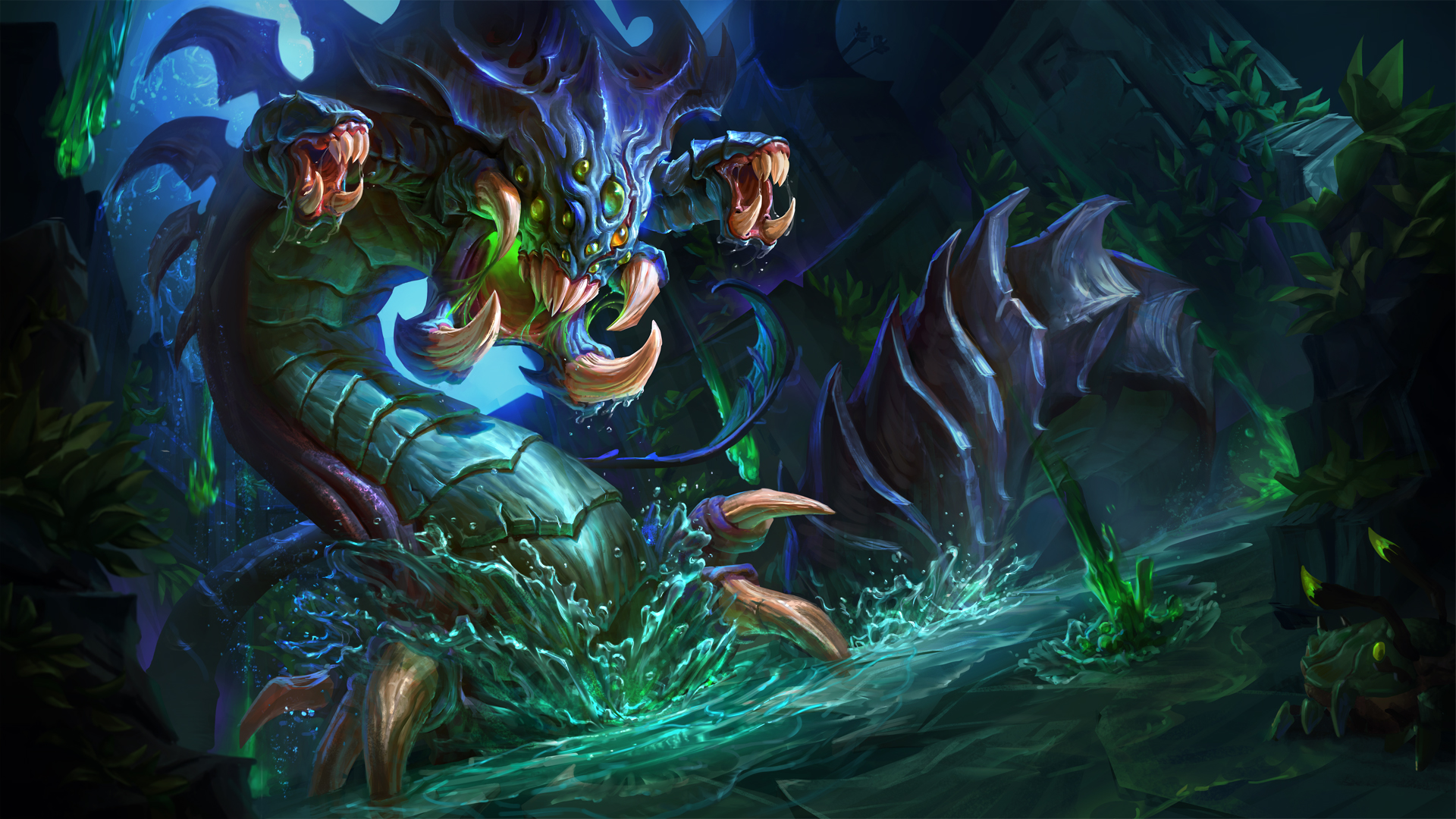
Baron Nashor Spawns at 10:00. Most of the time the final fights happen around the baron because it’s the second-best objective in the game that can help you close out the game.
7. The Three Phases and Scaling
There are three phases of scaling in the game. This isn’t only for beginners but also for experienced players to understand the different phases.
The three phases: early game, mid game, and late game. Those phases are to be considered very well because then you will know when your champ excels the best, and when you can win the game and when you can’t.
Here we explain the three phases:
Early game
This is when all the turrets are up and everyone is in their lane except for the junglers.
Until the jungler arrives, top and mid will mostly be 1v1 and bot lane will mostly be 2v2.
Mid game
When the first turrets begin to be destroyed, the mid game begins.
During the mid game, a match becomes messier than lane phase as some players will remain in lane while others will begin to roam around the map to help destroy other turrets or contest dragons or Rift Herald.
Late game
The mid game usually ends when all of the first turrets in the lanes are destroyed (sometimes, even more, are gone by then). This is the late game.
At this point, champions have acquired many of their major items, and teams begin to group for large teamfights around Baron and Elder Dragons.
This is very important to know because you will know when your team power spikes and when your teammates’ champ get their own power spike to use it to close out the game.